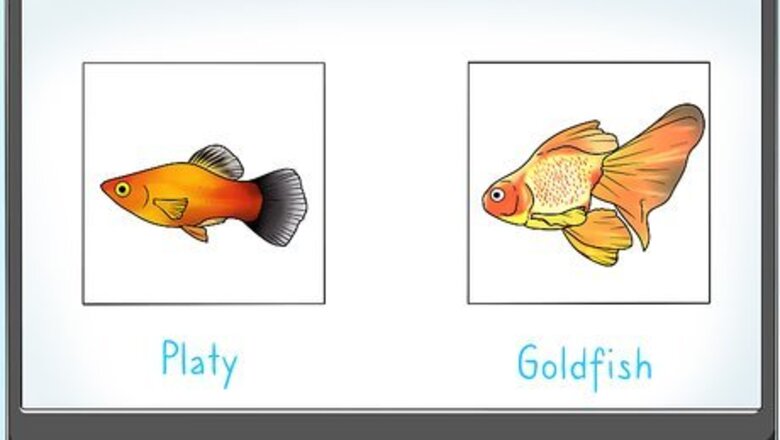
views
Choosing a Dry Fish Food
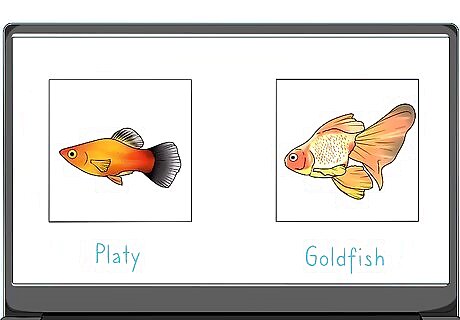
Research your fish species. People at the store where you purchased your fish should be able to help you pick out a fish food if you cannot find information specific to your species online. Find out whether your fish are herbivores, carnivores, or omnivores, and ideally the exact % of protein the fish species requires in its diet. Some exotic species require special diets, but most fish can be fed basic "fish food" flakes or pellet. However, don't go rushing to the pet store yet.
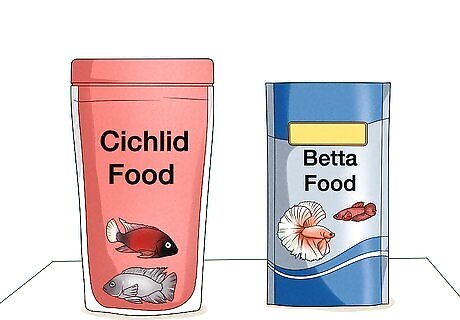
Find a fish food specific to your fish if possible. Many aquarium fish are fed with a general purpose fish food, or one intended for a broad category such as "tropical fish." As long as you read this section carefully, your fish may do fine with the right type of general food. However, if you can find a fish food specific to your fish species or group of related species, your fish will most likely be healthier and happier. These should be labeled clearly as "cichlid food," "betta food," etc. It's still a good idea to follow the other steps in this section to check a fish food's suitability before purchasing it.
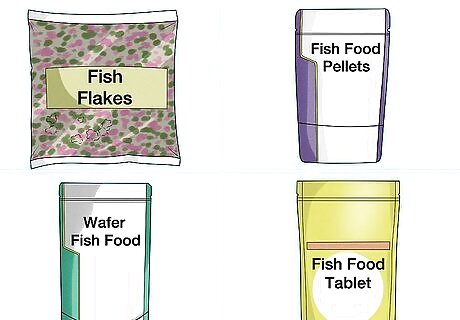
Pick food that floats, sinks, or slowly sinks depending on your fish's mouth shape. You can ask an aquarium store employee for advice if necessary, but often watching your fish's behavior or mouth shape will be enough to find out what type of food to buy. Bottom feeders such as catfish spend time at the bottom of the tank, with their down-turned or underside mouths searching for food. Mid-feeders have mouths pointing straight ahead and search for food in the middle of the tank. Surface feeders have upturned mouths and cluster to the surface when they are fed. If you are unsure what type your fish is, simply try out a food and see if they successfully find and eat it; some fish may not be restricted to one area. Flake food floats, and is only suitable for surface feeders. Grain, granule, or pellet food may float, sink slowly, or sink rapidly. Try to find more information on the label before buying. Wafer food sinks to the bottom, and is usually too large to be "stolen" by surface feeders. Tablet food can be dropped to the bottom of the tank, or, sometimes, stuck to the inside wall of the aquarium to provide food for mid-feeders.

Check the protein content of the fish food. Use the results of your research to narrow down the type of fish food to buy. Herbivores and omnivores require fish food made mostly from vegetable material, such as spirulina. Depending on species, their fish food should contain anywhere from 5% to 40% protein, so research the species thoroughly to narrow down your options. Carnivores, on the other hand require a diet between 45% and 70% protein, depending on species. Make sure the fish food you buy matches the needs of your fish. Bettas are carnivores and surface feeders. Their food should contain at least 45% protein, float, and be small enough to fit in the betta's mouth. Betta food is often sold in the form of tiny pellets. Goldfish are omnivores, and require 30% protein as adults, or 45% as young fish. Aquatic plant proteins are easiest for them to digest. They are surface feeders, so flakes are a good choice.
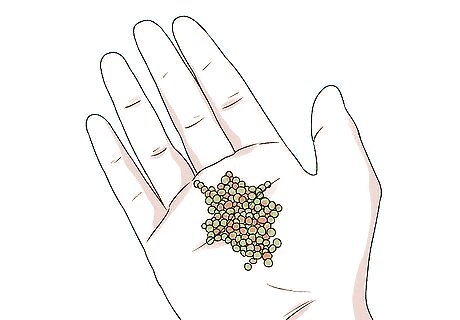
Make sure your food is small enough for your fish to eat. Many fish swallow their food whole, which means they are unable to break apart large flakes or pellets that do not fit inside their mouth. If the food you are giving your fish is going untouched, or if it looks bigger than your fish's mouth, crush it into pieces before feeding or find a smaller type of food.
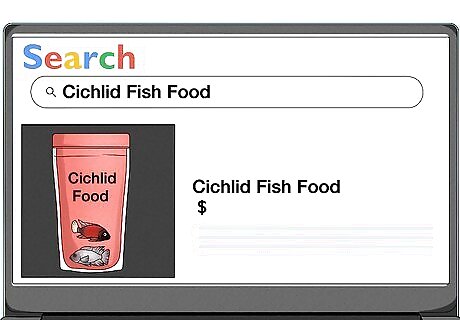
Look up fish food companies online. Before purchasing a dry fish food, search for the brand name and reviews. Well-respected companies that get good reviews from aquarium hobbyists are more likely to make high-quality fish food.
Feeding Your Fish Dry Food

Feed in tiny portions. While many people have heard that fish require a "pinch" of flake food each feeding, giving them too large a pinch can give the fish digestive problems or make the tank dirty and unhealthy. Whatever type of dry food you are using, only put in as much food as your fish can eat in 3 to 5 minutes. If you put too much food in the tank, scoop it out with a fine net. Warning: Betta fish should be fed much less than they can eat in 5 minutes. Two or three small pellets per betta is sufficient.
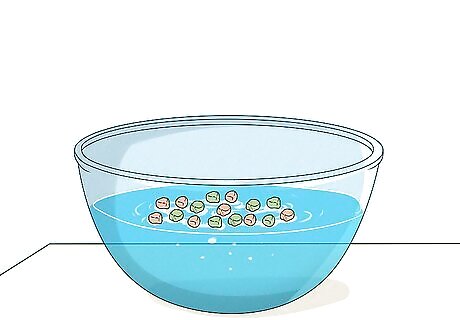
Soak pellet foods before feeding. Because many aquarium fish have small stomachs, pellets that absorb water and expand in size may cause digestive problems or bloating in your fish. Soak the pellets in water for 10 minutes before feeding so they expand before the fish eat it, rather than in the fish's stomach.

Feed the fish once or twice a day. Because it is much easier to overfeed most fish than to give them too little food, one feeding a day may be safer. However, if you are careful to give them small amounts of food as described above, you may feed the fish twice a day. Some aquarium owners prefer this because the fish become more active and interesting to watch during feeding.
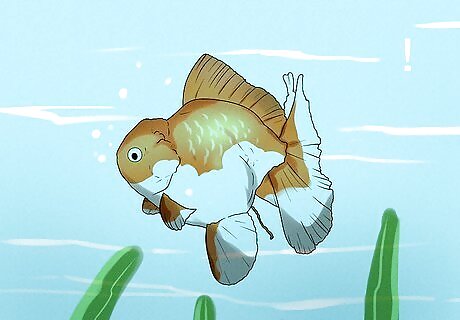
Look for signs of overfeeding. If a trail of poop is hanging from your fish, their intestine may be partially blocked due to overfeeding or the wrong type of food. If the water gets dirty enough that you need to do a water change more than once a week, you may be overfeeding the fish, or the tank may be overcrowded. Reduce the amount of food per serving or the number of servings per day to see if the problem goes away within a few days. Ask an aquarium store employee or fish raising hobbyist for advice if it does not.

Spread out the food so everyone gets some. Even within the same species, the larger or more aggressive fish may not leave enough food for the other fish. Reduce the chance of this happening by dividing the food and adding it to more than one area of the tank, or by sprinkling it evenly across the entire water surface.
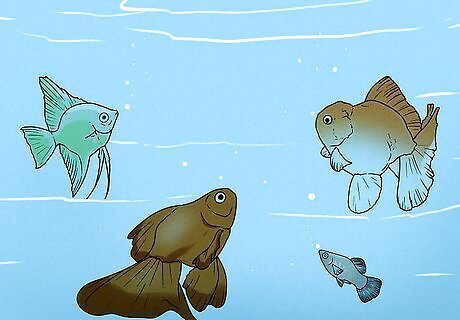
Watch for problems if you have multiple types of fish. If you have fish in your tank that feed in different areas of the tank, or on different types of food, you will likely need to purchase more than one fish food. Watch mixed-species tanks closely during feeding when you start them on a new food. You may need to find different combinations of food or feeding times if the fish at the surface eat all the food intended for the fish at the bottom. If some of your fish are active during the day and others at night, feeding them at two different times may help ensure that each fish gets enough food.
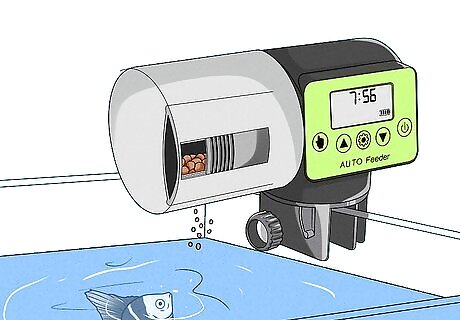
Consider your options while away on vacation. Leaving adult fish alone without food for a few days is almost always safe, and if you research your fish species online you may discover they can survive without serious risk for one or two weeks. For longer trips, or for young fish with more urgent food requirements, you'll need a way to feed them while you're gone. Choose from one of the following solutions: Use an automatic feed dispenser to dispense food at regular intervals. Make sure you supply enough food for the whole time you'll be away, and set the dispenser to release food once or twice a day. Test a feeder block or gel feeder before leaving. These blocks of dry or gel-covered food are left in the tank and eaten slowly. However, the dry blocks may cause dangerous chemical changes, while the gel variety sometimes go ignored. Test either variety for a few days before leaving so you can be sure there are no problems. Have a friend or neighbor feed them their usual flake food once every two or three days. Because inexperienced feeders often give too much food, it's best to place each pinch of food in a pillbox or other container with the day of the week carefully marked on it. Make it clear to the caretaker that overfeeding could kill your fish.
Supplementing Dry Food to Form a Complete Diet
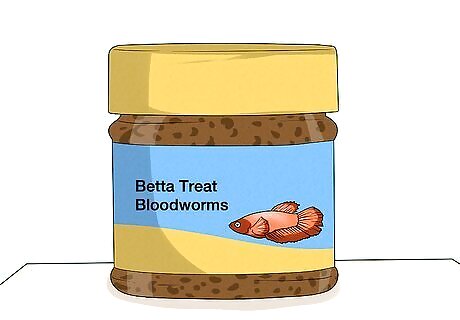
Obtain these supplements from safe sources. Insects, worms, and other animal food is most safely obtained at a pet store or aquarium store, while plant matter should be organically grown away from roadside exhaust. If a local aquarium expert tells you that collecting animals or plants from outdoors is safe in your area, then you may follow her advice. Otherwise, understand that collecting these supplements yourself carries the risk of disease, parasites, or harmful chemicals.
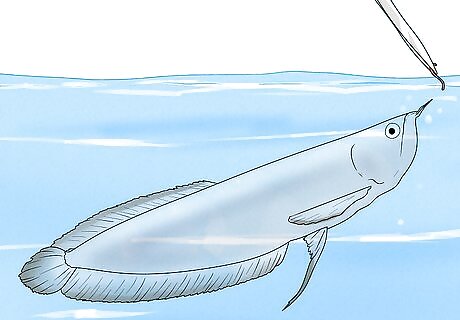
Feed carnivorous fish live or frozen animals. One to three times a week, give your fish frozen or live insects and other animal foods instead of their usual feeding. Always research your fish species' needs or ask an expert before selecting a food, as some foods can transmit disease or cause digestive issues when fed to certain species. Common foods available at pet shops include bloodworms, tubifex worms, daphnia, and brine shrimp. As with any feeding, only provide tiny amounts of food; enough to eat within 30 seconds may be enough for some species. Warning: Freeze-dried foods are another option, but should only be used occasionally due to the digestive issues large amounts can cause in some species, such as bettas. Avoid live tubifex worms, even ones sold at pet stores and raised on fish farms. They are known to cause diseases in many species, although the frozen variety is typically safe.

Feed most fish vegetables or algae. Herbivores and omnivores will likely be healthier and more colorful if you supplement their diet with the occasional plant matter, and even many carnivorous species can eat plants for useful nutrients. As always, research your fish species online before feeding it a new food. You can attach a piece of vegetable inside the tank with a vegetable clip, or cut it into small pieces to feed to your fish. Be sure to remove any uneaten vegetables within 48 hours, or it will start to rot in your tank. Carrots, zucchini, cucumbers, carrots, lettuce, and peas are just a few of the vegetables your fish might enjoy. Feed once every few days or as advised for your species. Using spirulina powder, infusoria, algae, or other plant matter sold at aquarium shops is another option, and a necessary one for tiny, juvenile fish too small to eat vegetable pieces. As long as the tank's surface or walls doesn't become overgrown with algae, you may add it according to instructions once or twice a day.
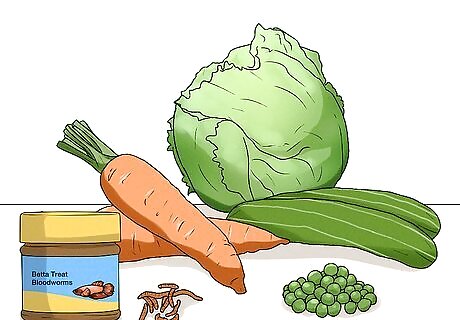
Feed your fish a variety of these supplements for greater health. Different animals or vegetables provide different vitamins, minerals, and other nutrients. Alternate between two or three types of animal or meat (for carnivorous fish) or vegetables (for other fish) for a better chance at providing all the requirements for healthy fish.
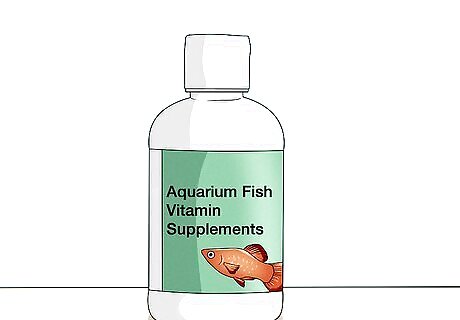
Provide straight vitamins or minerals if you notice problems. If your fish's bright colors fade, they become less active, or you notice other signs of poor health, your fish may be lacking certain nutrients. It's best to seek expert advice to gain a better idea of which vitamins or minerals your fish needs, or to identify other problems. Fish may need these supplements during times of stress, such as when new fish are introduced to the tank. If you are raising live food yourself, or purchasing live food from pet shops, you may feed them mineral or vitamin supplements which then get digested by the predator fish. This technique is called "gut loading."
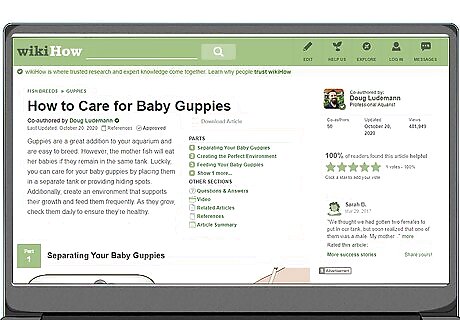
Seek specific advice for raising newborn fish. Newborn fish, or fish fry, are often too small to eat ordinary fish food. Because their dietary needs are often different than the adult fish, and they may require feeding every few hours, it's vital to seek specific advice based on the species. Research information online to make sure your fish fry have the best chance of survival.













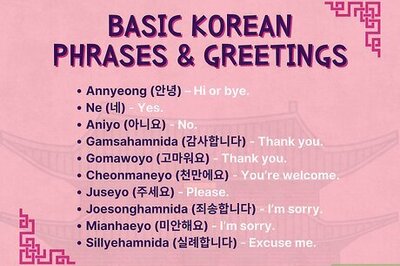
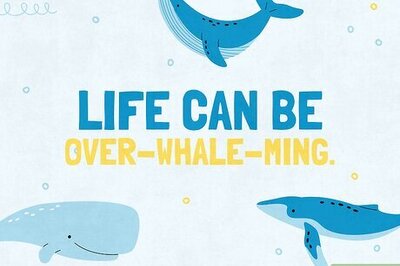
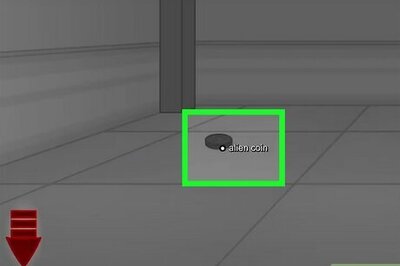
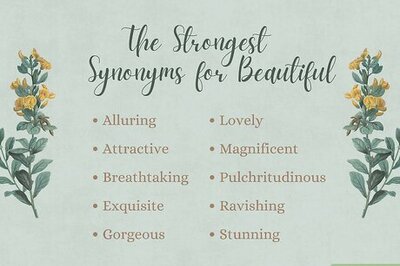

Comments
0 comment